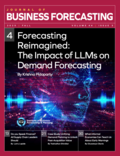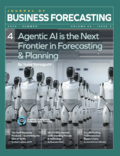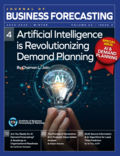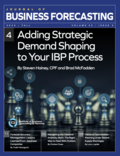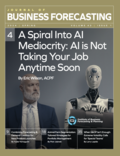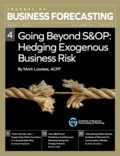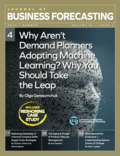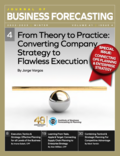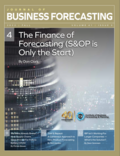 Cart
(0)
Sign In
Cart
(0)
Sign In
Journal of Business Forecasting Volume 44 | Issue 3 | Fall 2025
In this issue, the concept of demand planning as a conversation is introduced. It details how LLM's go beyond producing forecasts to answering questions about demand factors, as well as creating scenario plans. Other highlights of this issue include a practitioner's guide for Al implementation, including a strategic matrix to help leaders select high-value use cases, and a piece on the importance speaking the language of finance - critical to climbing the supply chain career...
Journal of Business Forecasting Volume 44 | Issue 2 | Summer 2025
This issue tackles the latest innovation in demand planning: Agentic AI. This technology can connect data, processes and people to produce forecasts and demand plans. It promises to be a great value driver for the field. Other highlights of this issue include excellent demand planning case studies in the pharmaceutical and publishing industries, and a practical playbook to help you navigate tariff-related...
Journal of Business Forecasting Volume 44 | Issue 1 | Spring 2025
In this issue we dive into real-world applications of AI, making it sure it adds value by making its outputs explainable to key stakeholders. The lead article includes a practical framework to explain different AI models. This issue also includes a vision of the world where global supply chains break down and we retreat into regional trading blocs. It is an invaluable resource to help manage supply chains in a world impacted by US tariffs. Other highlights include technical approaches...
Journal of Business Forecasting Volume 43 | Issue 4 | Winter 2024-2025
In this special issue, we dive into the real-world applications of AI in demand planning. In 2025, we are now seeing specific use cases across various aspects of the planning process, including machine learning for demand forecasting, AI-driven Forecast Value Added, and AI driven-lead time prediction. The lead article reveals the latest innovations in the space and how AI is transforming how we work as Planners. Highlights of this issue include a primer on getting started with AI and building...
Journal of Business Forecasting Volume 43 | Issue 3 | Fall 2024
The lead article of this issue reveals how mature planning organizations leverage demand shaping to optimize inventory according to supply constraints or surpluses and to serve strategic goals. Other highlights include a dive into forecast accuracy in Japanese companies from the country's preeminent academic and author, a primer on demand outliers that dispels some widely held misconceptions, and an interview with a planning leader who makes the case of IBP over...
Journal of Business Forecasting Volume 43 | Issue 2 | Summer 2024
The lead article of this issue invites you consider a new way for companies to do demand planning by using third-party providers. By lending expertise in various elements of the planning process, such services allow companies to get started and scale their planning processes with flexibility, and access expertise they wouldn't otherwise have. Could it be game changer for the field by bringing demand planning to sub $200m companies? Other highlights of this issue include a primer on the highly...
Journal of Business Forecasting Volume 43 | Issue 1 | Spring 2024
The lead article of this issue deals with AI in demand planning and forecasting and offers a warning that it can lead to standardized outputs and mediocre planning performance, and suggests that the human touch won't be replaced anytime soon. Other highlights of this issue include insight into how forecast accuracy is not necessarily correlated with improved decision making or business performance, and a new approach to new product launches that combines demand forecasting with demand creation.
Journal of Business Forecasting Volume 42 | Issue 4 | Winter 2023-2024
In this Supply Chain Planning special issue, you're invited to see the demand planning role through a supply planning lens. The lead article of this issue examines a rapidly emerging future state whereby demand planning must operate in the context of permanent supply constraints. Practical advice and examples are provided to help Planners navigate an age where infinite supply can no longer be relied upon. Other highlights of this issue include the merits and demerits of nearshoring to Mexico...
Journal of Business Forecasting Volume 42 | Issue 3 | Fall 2023
The lead article of this issue takes us beyond S&OP to risk planning, that is to say planning for major sea-change events. It reveals how to identify the forces of exogenous change that affects the success and - even existence - of a company, and how to plan hedges to mitigate their impact. Real-life case studies are included. Other highlights of this issue include an S&OP case study for the Oil & Gas industry and a qualitative analysis of safety stock calculation methods.
Journal of Business Forecasting Volume 42 | Issue 2 | Summer 2023
This issue dives into the question of why demand planning is slow to adopt machine learning, despite the technology being readily available. The core challenges are discussed, namely that that machine learning was built for the digital world and not the real world, how its outputs are difficult to apply to business decision making, and how the data requirements exceed what many companies can access. A practical pathway to get started in machine learning is provided. Other highlights of this...
Journal of Business Forecasting Volume 42 | Issue 1 | Spring 2023
The lead article of this issue covers crucial lessons learned from the pandemic and documents best practices for when the next crisis hits. Other highlights include a forecasting accuracy case study from Hershey's, a guide to going from supply chain to value chain, and an excellent interview with Ryan Harman, Director of Demand & Supply Planning at Black Rifle Coffee, who discusses the challenges of planning for a burgeoning social-media driven upstart.
Journal of Business Forecasting Volume 41 | Issue 4 | Winter 2022 – 2023
In this special issue of the Journal, planning leaders at top companies reveal how they connect operational planning to enterprise strategy. The lead article provides practical methods to ensure that strategic priorities are reflected in every planning response, ensuring that a company's competitive advantages are fully leveraged. Other highlights include a real-life case study of adapting planning to a unique business model, how to organize supply chains around how a company competes...
Journal of Business Forecasting Volume 41 | Issue 3 | Fall 2022
The lead article of this issue invites us to consider how over-optimized supply chains caused critical vulnerabilities well before COVID hit, and were equally to blame for supply shortages as spikes in demand. It discusses how we should reconsider our approach to Lean Methodology, SKU proliferation, BOM complexity, and inflexible production in order to avoid the same supply shortages when the next disruption hits. Other highlights of this issue include a breakdown of why IBP isn't working...
Journal of Business Forecasting Volume 41 | Issue 2 | Summer 2022
The lead article, written by the demand planning team at Sandoz, sheds light on empowering IBP with Artificial Intelligence, with lessons learned from their own journey. Other highlights include a new 20 Questions feature with a planning leader, and an FVA roll out case study.
Journal of Business Forecasting Volume 41 | Issue 1 | Spring 2022
The lead article of this value-packed issue deals with strategy-driven S&OP. It reveals how to connect S&OP to your company’s strategic priorities to better balance the Service, Cost and Cash triangle, and why Supply Chain must be involved in setting and delivering on targets for ROCE (Return On Capital Employed). Another highlight of this issue is a case study into using machine learning to forecast staffing requirements in the hotel industry (with practical insights applicable...
Journal of Business Forecasting Volume 40 | Issue 4 | Winter 2021-2022
This special issue on S&OP/IBP comes at a time when effective planning is critical to the success of your business. With COVID throwing demand assumptions into disarray and continued supply challenges, this issue will help you establish and maintain the processes that allow you to react quickly and effectively - whatever lies on the horizon. From getting started in S&OP to managing demand reviews and what to do in times of crisis, experts in the field have contributed their knowledge to make...








